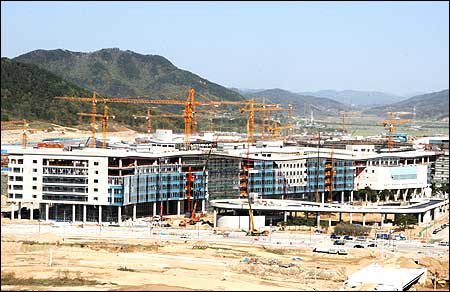Mini-capital Sejong City opens

Buildings for government offices are under construction in Sejong City, Saturday, a day before the opening day of the new administrative city. Sejong was officially inaugurated Sunday, and six government agencies, including the Prime Minister’s Office, will move there by the end of the year. (Photo: Yonhap)
Sejong City, an administrative center designed to house 36 government ministries and agencies, was inaugurated Sunday after a decade of political and social conflict.
The city was supposed to induce more balanced regional development, but still draws skepticism over the effectiveness of dividing government functions between Seoul and Sejong.
Government officials officially proclaimed the opening of the city, 120 kilometers south of Seoul, 10 years after the late former President Roh Moo-hyun pledged to build an alternative capital in his presidential campaign.
Sejong will be the country’s 17th large-sized municipality following Seoul, six metropolitan cities and nine provinces. It covers 465.2 square kilometers of land, about three-quarters the size of Seoul, spanning Yeongi County, parts of Gongju City and Cheongwon County.
By 2014, nine ministries and 27 government offices will move there Sejong — the Prime Minister’s Office will be the first in September, while the strategy and finance, and land, transport and maritime affairs ministries, and the Fair Trade Commission will follow by the end of the year.
People started moving to the city last December. The central government has been building infrastructure such as roads, electricity and gas supplies, hospitals and schools at a cost of some 8.5 trillion won.
The government expects around 20,000 people will move to Sejong by the end of the year.
The city aims to have a population of 300,000 by 2020 and 500,000 by 2030.
The city’s first Mayor Yu Hansik, a former Yeongi County head, will be inaugurated today; but President Lee Myung-bak, who hoped to scale down the city’s function, will not attend.
The Forward Unification Party called for Lee’s participation, saying in a statement that Sejong residents were angry at him not attending.
“It is narrow-minded to stain Sejong City’s historic meaning at this point in time. The government should support the city to maximize its function and bring national unity through it,” the party said.
Sejong City was first proposed by the liberal-minded Roh who promised to move the nation’s capital to the region in an effort to relieve overcrowding in Seoul and revive the economy of the region.
But the Constitutional Court ruled in 2004 that Seoul must remain the capital. Roh then changed the plan, keeping Seoul as the capital and making Sejong an administrative city.
His successor, the conservative- minded President Lee, attempted to scale down the project but faced protests from not only the opposition but also his own party.
The government expects Sejong City will lead to the decentralization of Seoul’s population and functions for more balanced development, as the capital and metropolitan area have 79 percent of central government offices, 83 percent of public firms, 91 percent of the nation’s top 100 businesses and half of the population.
But it is worried the administrative function may be crippled as Cheong Wa Dae, the National Assembly and several ministries will remain in Seoul. Public officials in each city will have to visit the other for meetings. <The Korea Times/Kim Rahn>

























































